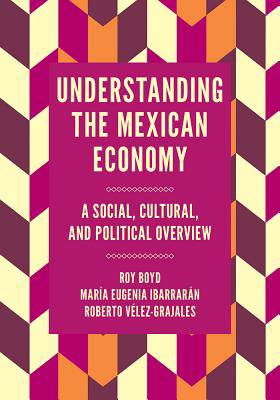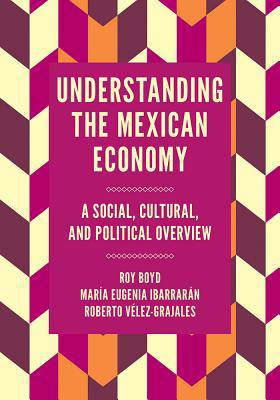
Je cadeautjes zeker op tijd in huis hebben voor de feestdagen? Kom langs in onze winkels en vind het perfecte geschenk!
- Afhalen na 1 uur in een winkel met voorraad
- Gratis thuislevering in België vanaf € 30
- Ruim aanbod met 7 miljoen producten
Je cadeautjes zeker op tijd in huis hebben voor de feestdagen? Kom langs in onze winkels en vind het perfecte geschenk!
- Afhalen na 1 uur in een winkel met voorraad
- Gratis thuislevering in België vanaf € 30
- Ruim aanbod met 7 miljoen producten
Zoeken
Understanding the Mexican Economy
A Social, Cultural, and Political Overview
Roy Boyd, Maria Eugenia Ibarrarán, Roberto Vélez-Grajales
Hardcover | Engels
€ 207,95
+ 415 punten
Omschrijving
The Mexican economy is a contemporary political flashpoint, and not just in Mexico, but in the United States, as well. Yet few people understand it in its full complexity, and fewer still understand the social, cultural, and historical factors that have helped to make it what it is today and that will continue to affect its future.
In Understanding the Mexican Economy, Roy Boyd, Maria Eugenia Ibarrarán, and Roberto Vélez-Grajales offer a comprehensive overview of these factors. They provide a full, historical, economic, and political context through which to understand the actions of the people and government of Mexico, and they give insights into how those actions impinge -- and might continue to impinge -- on the United States. They conduct a wide-ranging examination of the Mexican economy and investigate the causes of persistent problems such as economic stagnation, high poverty levels, and emigration abroad. Stressing the critical role played by economic incentives as well as Mexico's geography and political institutions, they employ a number of modeling techniques, including a specially designed computer model, to discuss a variety of topics including international trade, regional inequality, the informal economy, natural resource extraction, Mexico's "war on drugs," and the economic impact of US trade and immigration policy on both Mexico and the US.
For its comprehensive overview and the new insights it provides into these crucial and yet often tragically misunderstood issues, Understanding the Mexican Economy is essential reading not only for economists, but also for practitioners with a policy interest in Mexico, for students of Latin American studies, Development Studies, geography, and sociology, and for anyone with an interest in recent events and controversies around US-Mexican relations.
In Understanding the Mexican Economy, Roy Boyd, Maria Eugenia Ibarrarán, and Roberto Vélez-Grajales offer a comprehensive overview of these factors. They provide a full, historical, economic, and political context through which to understand the actions of the people and government of Mexico, and they give insights into how those actions impinge -- and might continue to impinge -- on the United States. They conduct a wide-ranging examination of the Mexican economy and investigate the causes of persistent problems such as economic stagnation, high poverty levels, and emigration abroad. Stressing the critical role played by economic incentives as well as Mexico's geography and political institutions, they employ a number of modeling techniques, including a specially designed computer model, to discuss a variety of topics including international trade, regional inequality, the informal economy, natural resource extraction, Mexico's "war on drugs," and the economic impact of US trade and immigration policy on both Mexico and the US.
For its comprehensive overview and the new insights it provides into these crucial and yet often tragically misunderstood issues, Understanding the Mexican Economy is essential reading not only for economists, but also for practitioners with a policy interest in Mexico, for students of Latin American studies, Development Studies, geography, and sociology, and for anyone with an interest in recent events and controversies around US-Mexican relations.
Specificaties
Betrokkenen
- Auteur(s):
- Uitgeverij:
Inhoud
- Aantal bladzijden:
- 232
- Taal:
- Engels
Eigenschappen
- Productcode (EAN):
- 9781787690660
- Verschijningsdatum:
- 6/11/2018
- Uitvoering:
- Hardcover
- Formaat:
- Genaaid
- Afmetingen:
- 157 mm x 231 mm
- Gewicht:
- 408 g

Alleen bij Standaard Boekhandel
+ 415 punten op je klantenkaart van Standaard Boekhandel
Beoordelingen
We publiceren alleen reviews die voldoen aan de voorwaarden voor reviews. Bekijk onze voorwaarden voor reviews.









